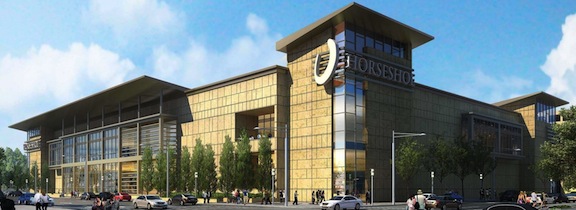
The new Horseshoe Casino Baltimore opened 10 weeks ago with much fanfare, including promos by Md.’s gover- nor and Baltimore’s mayor, and now is touted by sign- age on highways leading into the city from Washington.
IS GAMBLING BALTIMORE’S BIGGEST ATTRACTION?
ARE THE ORIOLES AND RAVENS LESS IMPORTANT?
Weak candidates and horrendous campaigns
OLD-FASHIONED BASEBALL VERSUS NEW
By David Maril
While wondering how many touchdown and passing yardage records the great Baltimore quarterback John Unitas would be shattering if he were alive and playing in today’s pass-happy NFL, it’s interesting to note the following:
![]() Would someone in Baltimore explain why there’s a sign on the Baltimore-Washington Parkway heralding the fact that the Horseshoe Casino is two miles away while there’s absolutely no mention of the Orioles’ and Ravens’ stadiums or the Inner Harbor?
Would someone in Baltimore explain why there’s a sign on the Baltimore-Washington Parkway heralding the fact that the Horseshoe Casino is two miles away while there’s absolutely no mention of the Orioles’ and Ravens’ stadiums or the Inner Harbor?
Is this a sign that city officials and political leaders feel casino gambling is what Baltimore is all about, and that travelers entering the city, after driving up from Washington, BWI, Annapolis and points south, don’t need to know about the more established and historical attributes that Baltimore has to offer?
How about a tasteful, well-designed sign welcoming people into “Baltimore, the birthplace of the Star Spangled Banner”?
Would it hurt, along with deciding to recognize the Orioles and Ravens, to mention the Baltimore Museum of Art and Walters Art Museum, along with Inner Harbor and city attractions?
With this type of short-sighted, sloppy thinking, you can almost expect some city politician to propose modernizing the national anthem, changing the words to “O! say can you see by the dawn’s early light, what so proudly we hailed from the Horseshoe Casino.”
![]() This $10 billion, or more, proposal to build a maglev high-speed railroad line that would get passengers from Baltimore to Washington in 15 minutes, and be extended through the Northeast Corridor as far as Boston, has little chance of getting funding and political backing.
This $10 billion, or more, proposal to build a maglev high-speed railroad line that would get passengers from Baltimore to Washington in 15 minutes, and be extended through the Northeast Corridor as far as Boston, has little chance of getting funding and political backing.
A GRADNDIOSE, RADICAL PROJECT
Instead of such a grandiose, radical project, why not put the focus on improving the existing track and train system?
On the local level, MARC ridership, between Baltimore and Washington, continues to grow and is a practical and reasonably priced alternative to sitting in traffic jams on I-95 and the BW Parkway. While Amtrak’s Northeast Corridor service has its good days and bad, passenger totals hit record setting levels each year.
![]() Maryland’s feeble governor’s race is convincing evidence that there’s room for a well-organized and high quality third party. But what is needed to be successful would be a party that represents moderates and centrist voters who would cross over from both of the existing parties.
Maryland’s feeble governor’s race is convincing evidence that there’s room for a well-organized and high quality third party. But what is needed to be successful would be a party that represents moderates and centrist voters who would cross over from both of the existing parties.
Most independent candidates represent extreme positions, from the far left or far right, or are focused strictly on one issue. For whatever reasons, the inside power-brokers of the two major parties seem to favor candidates and platforms that only appeal to the more extreme viewpoints.
The end result is a large bloc of voters who don’t feel they are being represented. In their mind, it isn’t a case of one extreme versus another or good vs. bad. They don’t want leaders who demonize the other side, and do want candidates who look for ways to find common ground and get things done for the overall good of all the people.
A SUPPORTER OF SOCIAL PROGRAMS
Hard as it is for Democratic Party leaders to believe, you can be a supporter of social programs and helping the people while believing things can be run more responsibly and efficiently. The answer shouldn’t always be to raise taxes, producing more fees and revenue for government.
It’s also possible to be a Republican, not be a right-winger and not want to shut down all social programs, leaving people on their own to fend for themselves.
Prospective 2016 presidential candidate Hillary Clinton, getting in some speech-tuneup practice campaigning for Anthony G. Brown in Maryland the other day, said voters don’t turn out for midterm elections because they are too busy.
That’s hardly the reason. They are no busier now than for other elections. The problem is weak candidates and horrendous campaigns.
Brown, serving as lieutenant governor, did nothing to convince any thoughtful person he is more than an inexperienced administrator being pushed along by Gov. Martin O’Malley and the state Democratic Party’s political machine.
Lawrence J. Hogan, conversely, has done little to ease fears he is an unimaginative, hardcore conservative with an overly simplistic approach that will get little accomplished.
Would it have been too much to have a candidate for governor with vision and creative ideas who was progressive on social issues but also practical and disciplined enough to focus on making government more productive and efficient?
CHRISTIE’S RANTING AND RAVING
![]() New Jersey Gov. Chris Christie’s recent ranting and raving probably killed whatever chance he had of making a convincing run for president as the Republican Party candidate in 2016.
New Jersey Gov. Chris Christie’s recent ranting and raving probably killed whatever chance he had of making a convincing run for president as the Republican Party candidate in 2016.
It looked as if he survived the taint of the George Washington Bridge traffic scandal, where highway lanes were closed down, creating traffic jams outside of Fort Lee as payback to that borough’s mayor for not supporting Christie.
However, in the past week Christie’s bluster is again raising questions about whether he is too unstable to be presidential material.
While his verbal sparring with a heckler at a Maryland campaign appearance for Hogan energized his diehard supporters looking for a John Wayne-type hero, this turns mainstream voters off.
His temper and his overreaction in the New Jersey Ebola situation, temporarily imprisoning a returning nurse from West Africa in a forced quarantine, make many people question his judgment and stability. Would voters really want such a hotheaded bully dealing with sensitive, pressurized crisis situations in the White House?

Madison Bumgarner, the MVP of the 2014 World Series, is the “Grover Cleveland Alexander of the New Millennium.” A personification of “old-fashioned baseball,” the Giants’ ace starter came in in relief last Wednesday in Game 7 to win the Fall Classic for the Giants, just as Alexander had done for the St. Louis Cardinals in 1926 in Game 7 against the New York Yankees after pitching & winning his second com- plete game the day before. Alexander drank heavily after winning Game 6; it’s unlikely that Bumgarner followed suit.
![]() Even though the four-game sweep by the Kansas City Royals of the Orioles in the American League Championship Series put a damper for Baltimore fans on the World Series, the Fall Classic was a terrific sports event to follow.
Even though the four-game sweep by the Kansas City Royals of the Orioles in the American League Championship Series put a damper for Baltimore fans on the World Series, the Fall Classic was a terrific sports event to follow.
One fascinating aspect was the clash between old-fashioned baseball and new.
On the one hand you had the Royals, with their rigid, specialized pitching structure, using relievers for specific innings out of the bullpen. On the other side, the Giants represented the no-DH National League’s more traditional style of baseball.
STRICT PITCH-COUNT PHILOSOPHY
In contrast to the strict pitch-count philosophy most teams practice today, old-school manager Bruce Bochy secured the World Championship by bringing in ace starter Madison Bumgarner on two days’ rest to pitch five scoreless innings out of the bullpen in Game 7.
This was classic, old-fashioned baseball you seldom see today, harking back to ironman mound duties of pitchers like Bob Gibson and Mickey Lolich.
Forget pitch counts. When post-season games are on the line, It’s how a pitcher is throwing and whether or not he has the guts and stamina to rise to the occasion.
![]() Speaking of the old-school nature of the Giants’ championship victory, it would have been great if Major League Baseball still practiced the tradition of having the network broadcasts on radio and television done by local announcers from the participating teams. ESPN radio and the Fox television network were OK, but somewhat generic in their approach.
Speaking of the old-school nature of the Giants’ championship victory, it would have been great if Major League Baseball still practiced the tradition of having the network broadcasts on radio and television done by local announcers from the participating teams. ESPN radio and the Fox television network were OK, but somewhat generic in their approach.
Those who don’t have satellite radio missed out on the excellent and exciting job turned in by the local San Francisco announcers.
Jon Miller — the former Orioles’ voice — Duane Kuiper, Mike Krukow and Dave Flemming are without doubt the best team of local announcers in Major League Baseball.
davidmaril@voiceofbaltimore.org
“Inside Pitch” is a weekly opinion column written for Voice of Baltimore by David Maril.
CHECK OUT LAST WEEK’S “INSIDE PITCH” COLUMN: click here
…and read archived Dave Maril columns by clicking here.






November 9th, 2014 - 2:38 AM
[…] to find full service anywhere. CHECK OUT LAST WEEK’S “INSIDE PITCH” COLUMN: click here …and read archived Dave Maril columns by clicking here. […]